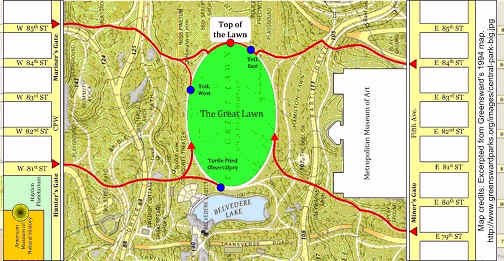|
NYSkies
Astronomy Inc |
||||
|---|---|---|---|---|
TOP OF THE LAWN
---------------
Who?
----
Top of the Lawn, more commonly called "TotL" (pronounced
"total"), is a loose association of urban astronomy enthusiasts
who gather on the northern perimeter path of Central Park's
Great Lawn. The core group of sidewalk astronomers is equipped
with binoculars, telescopes, and a passion for sharing our
skies. We are in the Park all year round to observe each season's
sky, typically on clear weekend nights.
In addition to the TotL team, there are regular visitors that
include dog walkers, cyclists, and pedestrians. These folks come
by with such regularity that they learned the fundamental motions
of the night sky and how to identify various targets in the sky.
However, all visitors are welcome to stop by for peeks and chat.
For further information you can contact Peter Tagatac at
'tags_p {AT} yahoo {DOT} com' or visit 'topofthelawn.blogspot.com'.
What?
-----
Defying popular belief, there are many celestial delights to
see with the eye and small optics. Many objects are challenged by
high background sky brightness. Others, like the Milky Way, can be
veiled from sight. Despite this impediment, TotL members help you
find the brighter objects in the sky, by eye and optics, and
provide some details about them.
In general, solar system bodies are easy to follow from the
city. They include the Moon, planets, major comets, and larger
asteroids. Man-made objects can be easy to observe, like
International Space Station, Space Shuttle, Iridium flares, and
large space capsules from other countries.
We can see many bright open clusters, double stars, planetary
stars, some nebulae, and globular clusters. Their number and
place in the sky vary with the season. Our city sky challenges
most galaxies beyond the Milky Way, yet the great Andromeda
Galaxy can be observed in optics as small as binoculars.
Why?
----
TotL members gather for the informal purpose of sharing our
fascination for the night sky. Passersby are captivated by the
vastness of space and distances to other worlds. They look into
the eyepiece with awe and wonder. For our group, these reactions
and expressed interest are reward enough to share with the public.
At a visit to TotL, we can help with the following:
- getting started - learn how to get your earings in the sky - how to use a planisphere - identify constellations and asterisms - how to find various deep sky objects - what to consider when buying equipment - how to use your binoculars or telescope - tricks and tips with daytime observing How?
----
Just show up - with or without optics. Travel instructions and
the map below detail our location in Central Park. We just ask
that you respect our equipment and be considerate of others. No
expert knowledge is required; an interest and positive attitude
are helpful.
Where?
------
Look for us at the northern perimeter sidewalk of the Great Lawn,
Central Park. That is approximately at 85th St. in the middle of the
park. One can enter the park on the westside from Hunter's Gate at
Central Park West (CPW) & 81st St. or Mariner's Gate at CPW & 85th
St. at the north side of each entrance, follow the sidewalk straight
into the park, crossing the road, West Drive, towards the Great Lawn.
The M10 bus stops nearby at 84th and CPW and the B & C subways
stop at 86th and CPW.
If one enters the park from the east, use the entrances north or
south of the Metropolitan Museum of Art and walk westward along the
path. From the southern entrance one crosses East Drive under the
bridge. From the sidewalk north of the "Met", one follows the
sidewalk into the park and crosses East Drive. The sidewalk continues,
leading into the Great Lawn.
M1, M2, and other buses run south and stops around 84th & 5th Ave
while the 4, 5, or 6 subway stops at 86th & Lexington Ave.
Once you arrive, walk north on the perimeter sidewalk around the
Great Lawn. We'll be at the top, or maybe a little further east.
This map indicates meeting places relative to the Great Lawn,
Central Park. The red circle indicates our primary meeting place. There
are some events where the horizon is more favorable when observed from
the blue circles, for example lunar eclipses from Turtle Pond Observatory.
A Google map is found here: 'maps.google.com/maps/ms?ie=UTF8&hl=en &t=h&msa=0&msid=108562171810400374459.000456cfa3a5f12202c19 &ll=40.781411,-73.966377&spn=0.004135,0.006909&z=17' Last update on 15 June 2009 |
||||
| Copyright 2007, NYSkies Astronomy Inc General inquiries: nyskies@nyskies.org | ||||
